At 8:30 this morning, the team began deploying the last of the three coastal surface moorings. Like the other deployments, this one was like a choreographed ballet, with each participant ready in the wings to execute the perfect next move. By mid-day the deck was temporarily clear of all mooring-related equipment, ready for the recovery process of three moorings to begin.
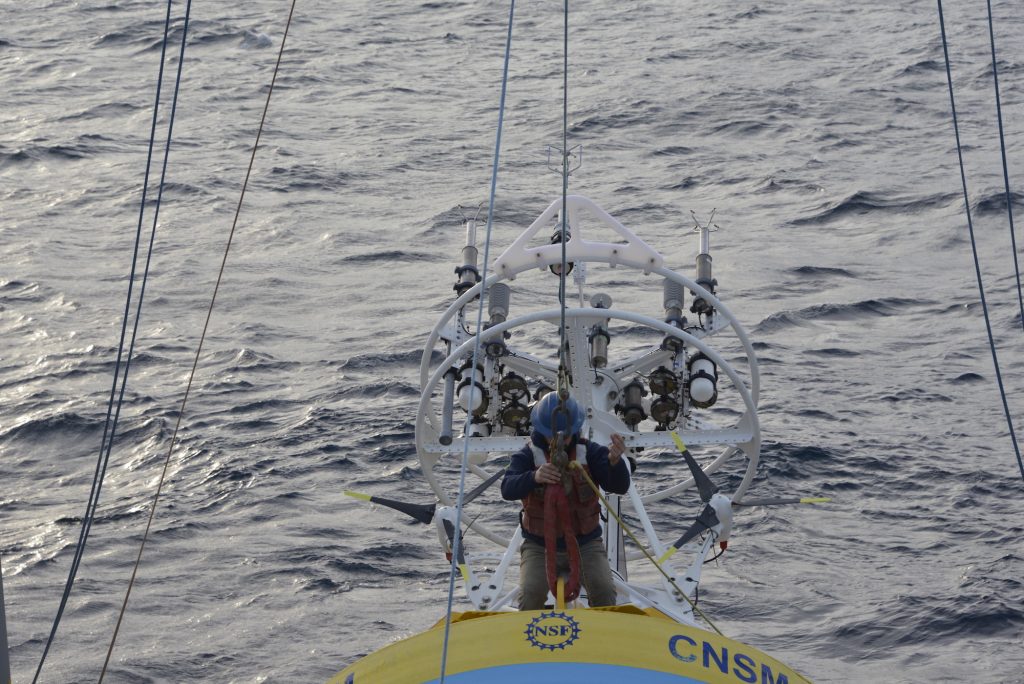
The third Coastal Surface Mooring was put into the water this morning from the stern of the R/V Neil Armstrong. Technician Nico Llanos was atop the buoy rigging it for launch.
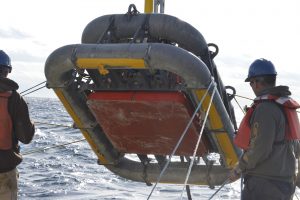
A multi-function node is the last component of the mooring to go into the water. It is equipped with multiple instruments, and receives power from the buoy at the surface. The orange interior square seen in the center of the MFN is the anchor to keep the mooring in place.
Documenting this trip, I realized this morning that the Pioneer 17 expedition is essentially a construction and demolition site on the open ocean. The various components that make up a mooring (buoy, near-surface instrument frame, floats, and the multi-function node) are connected while at sea, and ultimately comprise one long and heavy mooring being placed into the sea. The afternoon promised the reverse of this process.
As the days have worn on, it has become eminently clear to me that safety is the primary issue aboard the R/V Neil Armstrong. Hard hats, flotation vests, and steel-toed shoes are only the beginning of the process of keeping everyone safe. Each move to secure, unsecure, and launch and relaunch equipment is planned in advance and executed with precision. Pioneer 17 members and crew continually check in with each other to ensure everyone is aware of and in place for the next move of exceedingly heavy equipment. The anchor, alone, for example weighs some 7,000 pounds. The folks on the stern are connected by radio to the captain on the bridge so the work on the backend and movement of the ship are precisely coordinated. These verbal communications are supplemented by hand signals on deck.
After noon, efforts turned toward recovery. After the mooring was acoustically released from its anchor, the ship maneuvered along side the buoy. A member of the deck crew used a hook on a long pole to hook the buoy with the recovery line. The buoy was then pulled onto the back deck with the rest of the mooring trailing astern. The buoy was covered with gooseneck barnacles and other unidentified black slime on the areas in contact with the water.
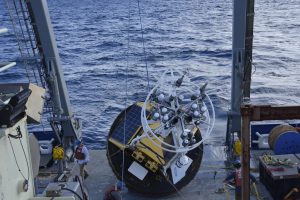
The buoy was brought on deck and immediately secured with lines, and ratchet straps. Tuggers were used to tighten the lines, ensuring the buoy remained stationary.
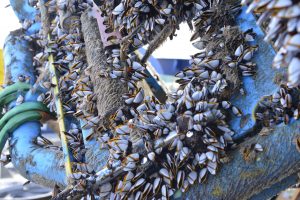
The bottom of the buoy apparently was the perfect substrate for a plethora of gooseneck barnacles. All components of the mooring will be cleaned and refurbished for the next deployment in spring 2022.
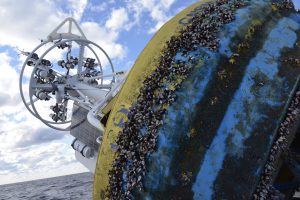
Another view of the barnacle population that have taken residence on the buoy. The blue bottom paint is meant to discourage organisms from attaching to the buoy.
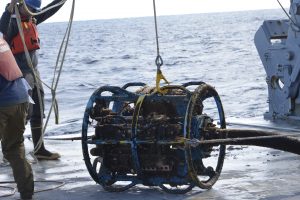
The near-surface instrument frame (NSIF) which holds a number of instruments, turned black with slime after spending six months below the surface. The discoloration is caused by marine life using the NSIF as a home base. All components of the mooring were similarly inhabited and made for a fairly odiferous back deck.
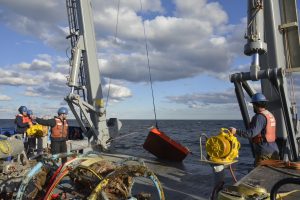
The mooring’s 7,000-pound anchor was the last to be recovered. The winch and an A-frame were used to lift the anchor onto the deck, with tugger lines helping to prevent the anchor from swaying. Once all the mooring’s components were securely on deck, the team members found them more permanent locations to make room for the recovery of two additional moorings in the coming days.
Images and Text by Darlene Trew Crist©WHOI.
Recent Updates